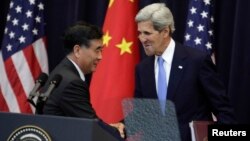“The first Strategic and Economic Dialogue [in 2009] was . . . a landmark event . . . a new chapter in the relationship between the United States and China,” U.S. Secretary of State John Kerry said at the opening of the Fifth Round of the U.S.-China Strategic and Economic Dialogue.
“With each passing year, we have been able to build on this dialogue and . . . made it into the key mechanism for managing cooperation and competition between our countries.”
The Strategic Track of the dialogue identified many areas for further cooperation:
In the area of “Enhancing Bilateral Cooperation,” the Cyber Working Group met for the first time, the third round of the Strategic Security Dialogue was held the day prior to the Strategic and Economic Dialogue, military-to-military relations were strengthened, and bilateral dialogues on human rights and nonproliferation are set to continue.
In addressing “Regional and Global Challenges,” in-depth consultations were held on the Korean Peninsula, Asia Pacific, Syria, Afghanistan, and Sudan and South Sudan. Both countries agreed to call on Iran to take concrete actions in satisfying the concerns of the international community through negotiations with the P5+1 – United States, Russia, China, Great Britain and France, plus Germany.
Concerning “Sub-national Cooperation,” there are two hundred sister-city and sister-state relationships between the United States and China. Both sides welcomed more relationships that foster innovation, business opportunities, and people-to-people exchanges.
The United States and China also agreed to enhance cooperation on energy, environmental protection, health, science, technology, and agriculture.
The two sides agreed to continue collaborating under the Ten-Year Frame-work on Energy and Environment, the Joint Commission Meeting on Science and Technology, and additional forums on such issues as peaceful uses of nuclear energy, illegal logging, environmental research and cooperation, marine science, and many others subjects.
“When [the United States and China] work together to build trust and goodwill and understanding, it opens the door to greater collaboration,” Secretary Kerry said. “In a world where increasingly governments are failing and populations are rising up . . . it is important for the two leading nations of the world to find a way to set an example for success between governments.”
“With each passing year, we have been able to build on this dialogue and . . . made it into the key mechanism for managing cooperation and competition between our countries.”
The Strategic Track of the dialogue identified many areas for further cooperation:
In the area of “Enhancing Bilateral Cooperation,” the Cyber Working Group met for the first time, the third round of the Strategic Security Dialogue was held the day prior to the Strategic and Economic Dialogue, military-to-military relations were strengthened, and bilateral dialogues on human rights and nonproliferation are set to continue.
In addressing “Regional and Global Challenges,” in-depth consultations were held on the Korean Peninsula, Asia Pacific, Syria, Afghanistan, and Sudan and South Sudan. Both countries agreed to call on Iran to take concrete actions in satisfying the concerns of the international community through negotiations with the P5+1 – United States, Russia, China, Great Britain and France, plus Germany.
Concerning “Sub-national Cooperation,” there are two hundred sister-city and sister-state relationships between the United States and China. Both sides welcomed more relationships that foster innovation, business opportunities, and people-to-people exchanges.
The United States and China also agreed to enhance cooperation on energy, environmental protection, health, science, technology, and agriculture.
The two sides agreed to continue collaborating under the Ten-Year Frame-work on Energy and Environment, the Joint Commission Meeting on Science and Technology, and additional forums on such issues as peaceful uses of nuclear energy, illegal logging, environmental research and cooperation, marine science, and many others subjects.
“When [the United States and China] work together to build trust and goodwill and understanding, it opens the door to greater collaboration,” Secretary Kerry said. “In a world where increasingly governments are failing and populations are rising up . . . it is important for the two leading nations of the world to find a way to set an example for success between governments.”

















